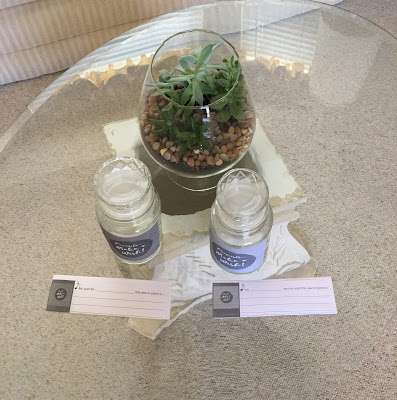Music Goals
Leila came up with a great idea,
Make A Wish Jar. Read all about it,
Do Simple Better. I created my own approach using her templates and absolutely love the idea. At the beginning of the school year, I usually ask my students make
"Time Tunnels." They would write their goals on an index card and place it inside home-made toilet paper tunnels. I really like the new approach of the jars and can't wait to use them! There is a jar for the parents and the students. A win-win situation!
The Importance of Praise
Sincere praise from the teacher is one of the most motivating factors in teaching piano. Praise often accomplishes more than admonition. Since students learn something new on practically every page of their lesson books, the teacher has the opportunity to remind them that they are constantly making progress. Over at
4dpianoteaching.com, you will see a plethora of affirmations in this fantastic word cloud!
High or Low?
Older students enjoy a sound approach to reading taught by intervals. Second, third, fourth and fifth intervals are discussed within the first few weeks of lessons. Beginner students will figure out the sound of the note you are playing on the piano. As they listen, they will begin to discover if they hear a low note on the low end of the piano or a high note. There are all kinds of animals to use here. I like frogs and bees for listening to the rhythm in this approach.
Fingering
For the little ones, I love to trace their hands and ask them to number their piano hands. I am a WunderKeys teacher and with my preschoolers, we use finger puppets and each finger is assigned an animal.
It's fun to play two notes and ask young students to listen carefully. Are the notes same or different?
Also, this would be the time to discuss the music alphabet... starting from A to G. I like to introduce C Position right away but I know many teachers who dive right into Middle C Position. That's good, too. Learn Twinkle Twinkle Little Star, Jingle Bells and for sure, Heart and Soul! I like
Frogs Wearing Flip Flops by Susan Paradis using the 4th finger on the F note. It helps to strengthen this weak finger.
Books Recommended
A Lesson Book, Theory Book and Recital Book would be a good start. Some enjoy exercise and scale books, too. There are numerous supplemental resources to order online. Here's just a few:
- Faber & Faber "PreTime" Series
- WunderKeys Piano for Pre-Schoolers
- Dozen a Day Preparatory Book
Four Part Curriculum
There's a wonderful website that I recommend for music teachers,
https://funmusicco.com/.
Janice Tuck shares that "We're not teaching music, we're teaching
children." She breaks the curriculum down into 4 parts:
Key Concept 1
USA
- Create, perform and record composition.
- Demonstrate selected and organized musical ideas for an improvisation, arrangement, or composition to express intent, and explain the connection to purpose and context.
Australia
- Create, perform and record compositions by selecting and organizing sounds, silence, tempo, and volume.
UK
- Improvise and compose music for a range of purposes using the inter-related dimensions of music.
Key Concept 2
USA
- Be actively involved in making music.
- Perform music, alone or with others, with expression and technical accuracy, and appropriate interpretation.
Australia
- Practice singing, playing instruments and improvising music, using elements of music including rhythm, pitch, dynamics and form in a range of pieces, including in music from the local community.
UK
- Play and perform in solo and ensemble contexts, using their voices and playing musical instruments with increasing accuracy, fluency, control, and expression.
Key Concept 3
USA
- Listen to detail.
- Rehearse to refine technical accuracy and expressive qualities, and address performance challenges.
Australia
- Develop aural skills by exploring, imitating, and recognizing elements of music including dynamics, pitch and rhythm patterns.
UK
- Listen with attention to detail and recall sounds with increasing aural memory.
Key Concept 4
USA
- Listen with intent.
- Relate artistic ideas and works with societal, cultural, and historical context to deepen understanding.
Australia
- Identify intended purposes and meanings as they listen to music using the elements of music to make comparisons, starting with Australian music, including music of Aboriginal and Torres Strait Islander Peoples.
UK
- Appreciate and understand a wide range of high-quality live and recorded music drawn from different traditions and from great composers and musicians.
Meet My Students!
First Week Lesson Plan
Before students get a chance to dive into 'method books'... Well, I like to assign them some simple songs to work on with memory. Kids learn to play Chopsticks, Happy Birthday, Heart and Soul... and of course, the C Major Scale.
Next time, we will discuss the importance of reviewing scales!
This school year I will be working with 12 children, several adults and a few students with special needs. I sincerely wish you a wonderful, successful year ahead with piano learning/teaching!
Be sure and check out these free video lessons and sequence,
4videos.
Blessings,
-- LadyD
"The beautiful thing about learning is that no one can take it away from you." B.B.King
























![Validate my Atom 1.0 feed [Valid Atom 1.0]](valid-atom.png)







